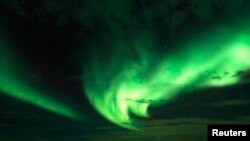A giant sunspot has turned toward Earth, prompting a 75 percent chance of a geomagnetic storm that could be felt on some parts of our planet.
While solar activity has been relatively quiet recently, Active Region 2529, as the spot or solar flare is called, could cause minor issues on Earth north of 60 degrees latitude. The sunspot is several times the size of Earth.
Scientists at the U.S. government's NOAA, say a solar storm could reach Earth Wednesday or Thursday, and could cause “weak power grid fluctuations” and “minor impact on satellite operations.”
It could also cause an aurora, northern lights visible as far south as Michigan and Maine in the United States.
The sunspot is not extremely active, but according to the EarthSky website, it has caused “a few small solar flares” and “minor coronal mass ejections,” which are bubbles of superheated gas and charged particles blasted into space from the sun’s upper atmosphere, the corona.
The sun makes one full rotation at its equator every 25 days, with the sunspot cycle peaking every 11 years, according to Universe Today.
AR 2529 is a classic late cycle spot, the site said, as it is very near the sun’s equator. When a new cycle begins, spots appear in the sun’s higher latitudes.









